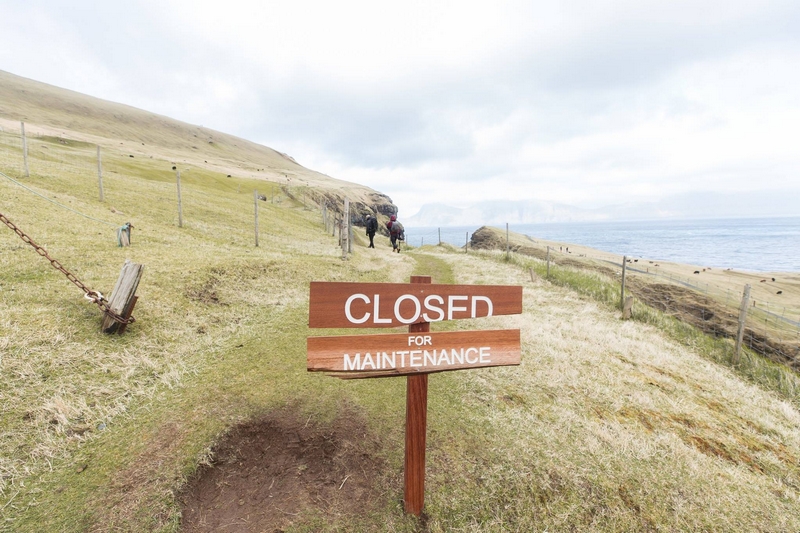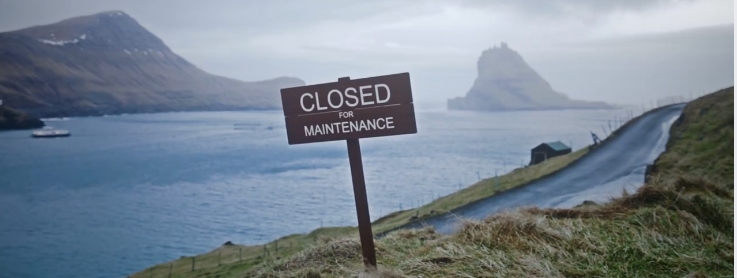
visitfaroeislands.com @facebook.com/VisitFaroeIslands
The road tunnel to Gásadalur was built 15 years ago. Until then, residents of this tiny village on Vágar, one of the Faroe Islands, relied on intermittent boat access below the cliffs or, more commonly, braved the 45 degree-slope of a narrow track that climbs 500 metres over the mountain south of the village. The postman had to make the climb three times a week, making him one of the fittest men in the Faroes.
It wasn’t just the postman who made that trek, coffins were carried over the mountain to the cemetery at Bøur 5km away, as were sick people who needed the doctor. Only 11 people live in Gasadalur today, and without the tunnel it would probably have become one of Faroes’ abandoned villages. Today, I’m doing the climb with several local men, plus three mathematicians from Washington DC, a pharmacist from Glasgow, a civil servant from London, two Finnish students and two biochemists from Bratislava. They’re all volunteers who have come to the islands as a part of a tourism initiative that declared the country “closed for maintenance” for one weekend last month.

“As soon as we heard about it we signed up,” said Rachel Levy, one of the American volunteers who travelled here with her husband Sam and their college-age daughter Miriam. “It’s definitely the way we like to travel, meeting local people and feeling we’ve made some kind of positive contribution.”
We “voluntourists” (as Visit Faroe Islands calls us) have the task of clearing loose stones from the path, and hammering wooden stakes into the grass to mark a safe, easily visible route over the mountain. Historically, clearing loose stones was done by the villagers, but thanks to the road they rarely walk over the mountain these days.It’s being refurbished mainly for the burgeoning numbers of tourists who explore this archipelago of rugged mountains, prolific seabirds and wild-looking sheep. Gásadalur also has one of the Faroes’ most-photographed sights: a waterfall that gushes straight from the cliff face into the Atlantic below.
We reach the ridgeline after 50 minutes of hard climbing, and the wind is so strong everyone huddles behind a stone cairn to avoid being blown over. These islands are regularly blasted with the highest wind speeds in Europe.

One of the masterminds behind this weekend is Jóhan Pauli Helgason, development manager for Visit Faroe Islands. He says the project had several strands: “Yes, it was a marketing campaign but it was also about making genuine improvements to the tourist experience, and providing visitors and locals with a proper cultural exchange. We see that as a more sustainable version of tourism for a country with just 50,000 people.”
Helgason managed the logistics, getting 105 volunteers from 25 countries safely in and out of the country and distributed across 10 projects selected in collaboration with district councils. The sites included the puffin colony on Mykines island, the natural rock harbour at Gjógv and – the Instagram favourite – the high cliffs at Trælanipa, where the archipelago’s largest lake seems to float hundreds of metres above the Atlantic. One batch of volunteers also went to the southernmost island of Suđuroy (a two-hour ferry ride from the capital, Tórshavn) with everyone staying in guesthouses and local homes. Crucially, no one fell off a mountain or twisted an ankle in the mud.
Making the paths clear and safe was an essential. At Mykines and Trælanipa especially, the fragile grass and thin northern soil has suffered erosion and become hazardously slippery under increased foot traffic – not surprising in a country with 300 days of rain a year. Where once only shepherds and their flocks walked, there is now a significant increase in hikers and sightseers. Minimising the impact of walkers is a serious ecological issue. At 62° north, vegetation recovers slowly, and much of the outfield provides important nesting sites for ground species like snipe, oystercatchers and skuas.

Footpaths connect most of the settlements, and these are open to everyone, but in the Faroes almost all mountain pasture is private property. Some farmers have imposed fees on the most popular routes, but there is no clear consensus on how to manage the planned increase in visitors over the next few years. Currently the islands see about 110,000 visitors, half of them from cruise ships that visit Tórshavn for a few hours.
The original aim was to double tourist revenues by 2020 and it seems to be working, thanks in part to efforts at making the islands a must-see destination for Instagrammers and social media influencers. Visit Faroe Islands director Guđriđ Højgaard is optimistic: “We know our islands are special. But we believe we can increase our market without damaging the essence of what it means to be Faroese.”
Jóhan Jógvansson farms the land around the historic settlement at Saksun, a location familiar to British TV viewers from the Specsavers ad where a short-sighted shepherd mistakenly shears his sheep dog. Hobbitish turf-roofed houses overlook an old whitewashed church above a glittering lake accessed via a single-track road. Jógvansson claims his farm work is interrupted by the tourist traffic. “Tourists come here for one reason only,” he says over tea in his neat wood-panelled kitchen. “They want to photograph my farm. But what do I get out of it? My tractor gets caught in traffic jam and I have to check there isn’t someone peering through my window when I go to the shower.”

The Faroese Farmer’s Association wants to remedy this and ensure its members don’t get left out of the growing tourist economy. Sigert Patursson, a rosy-cheeked Viking with a bushy blond beard, is the chairman. He strolls across the fields of his farm outside Tórshavn in a chunky-knit sweater oblivious to the cold breeze. “We want farmers to think about offering walkers something that could bring in a little extra money. They could do bed and breakfast, packed lunches or guided tours. It’s hard enough making a living from the land here, and we need to make sure that we get a slice of the tourism pie.”
It’s clear to anyone from the wider world that Faroes is not suffering anything like overtourism. Most Faroese people see tourists as an asset, and are still flattered that people want to know more about their culture. Ditte Mathilda Joensen runs small-scale photography tours through her company Veingir. “I want visitors to meet locals, and become friends. For me, tourism has to be a two-way process, and I hope we don’t lose sight of that as we grow.”
The “Closed for Maintenance” weekend may well be a vision of what tourism should be like for many small communities. One of the volunteers, Lene Finnestad, a doctor from Oslo, told me she would happily do such a project again. “We worked in collaboration, befriending Faroese people and other volunteers. We all had very similar values. You actually feel like you’ve given something back instead of just consuming what the country has to offer.”
Knowing the Faroes well, I admit I wondered if voluntourism would achieve much in practical terms. On the island of Nólsoy, local resident Tjóðhild Patursson was adamant that the visitors had helped this small community in a tangible way.
“Many visitors take the wrong track across the mountains. If they get lost or injured, we have to take care of them. Our local municipality hasn’t had the time, the money or the manpower to waymark the route, even though we have been talking about it for a couple of years. What the visitors have achieved in just two days is remarkable.”
• The next Closed for Maintenance weekend is in April 2020 (dates tbc). Volunteers pay for their flight to the Faroes (about €280 return) but are given full-board accommodation while there. Details at visitfaroeislands.com
guardian.co.uk © Guardian News & Media Limited 2010
Published via the Guardian News Feed plugin for WordPress.


